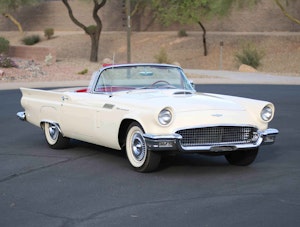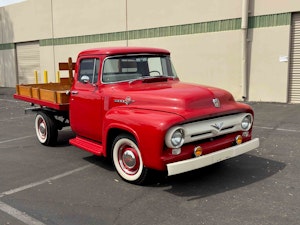Media | Articles
This Porsche 908/02 “Flunder” Never Floundered
Perhaps more than any other car company, Porsche faced enormous change in the period from 1960 to ’70. On the road, the seminal 356 gave way to the definitive 911, and Porsche finally went mass-market with the 914. The changes on track were even bigger.
At the beginning of the ’60s, Porsche raced the pocket-sized, class-competitive, four-cylinder 718. By the end of the ’60s, it had the 12-cylinder, all-conquering 917. The years in between saw a rapid succession of newer, better, faster prototype racers. The 908 was one of them, and it wound up being among the most successful and versatile race cars Porsche ever built. Which really is saying something. Among those 908s, this 908/02 Spyder, up for auction next week, has one of the best résumés of any 908.

In 1968, with the FIA changing the displacement for its Group 6 prototype category to an F1-sized 3 liters, Porsche further developed its 907 (a 2.2-liter car) and adapted it to accept a new 3.0-liter unit. They called the new racer, naturally, the 908. Air-cooled and with two-valves per cylinder, its new flat-eight made about 350 hp for most of its career, and although this was less than the output from some of its F1-derived competition like Ferrari and Matra, the Porsche eight was meant from the get-go to last a full endurance race, not just a relatively short Grand Prix. The 908 was also a very light car, typically less than 1500 pounds.
Early 908s were streamlined longtail coupes. They were drop-dead gorgeous but also unstable at speed, terrifying to drive, and prone to numerous teething problems. Regular aerodynamic tweaks with flaps and appendages changed the 908’s appearance drastically in a short time, but the results for it in the 1968 season were mixed, although Porsche did finish second in the World Sportscar Championship.

In 1969, Porsche was forging ahead with the brand-new 917, but nevertheless further developed the 908 into the 908/02, which was not a coupe but an open short-tail spyder. As it did the year before, Porsche continually tweaked the 908’s bodywork for better aerodynamics. One of the most important trips to the Stuttgart wind tunnel resulted in the Flunder (Flounder) body, nicknamed for its flatter, fishier appearance, including the nearly enclosed passenger area. The new shape debuted at the Nürburgring 1000km and won, notching Porsche’s third straight victory at the event. Porsche also won the World Sportscar Championship in 1969, mostly thanks to the 908, although one of the longtail coupes finished just 120 meters behind the winning Gulf Ford GT40 at Le Mans.
Marketplace
Buy and sell classics with confidence
A new version, the 908/03, debuted for 1970, with Porsche aiming to use the more nimble 908 on tracks less suited to the powerful 917. The two-car strategy worked, and Porsche won the World Sportscar Championship in both 1970 and 1971. Rule changes for 1972 left the 5.0-liter 917 effectively banned, and the 3-liter category became the fastest class, but Porsche nevertheless sold off its 908s to customers. Remarkably, a privately entered 908 finished third at Le Mans in 1972, and others were competitive into the early 1980s, by then running turbocharged engines. At the Nürburgring 1000km, a Porsche 908 took the checkered flag in three different decades—four straight wins from 1968–71, and again in 1980.


This 908, chassis 908/02.005, started out as a factory 908/02 spyder. It first raced at Sebring in 1969, then was used as a training car for the Targa Florio, which Porsche won. Later in the year, it went to the Martini International Racing team and for the 1970 season got the more enveloping Flunder bodywork. It raced at Sebring, Brands Hatch, Monza, the Targa Florio, and Spa, where it notched a class win.
For Le Mans, its shape was further revised with longtail rear bodywork better suited for Le Mans’ high average speeds. It was also fitted with a transmission oil cooler (an overheated gearbox forced another Flunder to retire from Le Mans the year before). The Martini team fielded a single 917, done up in its famous blue and green psychedelic livery, along with 908/02.005 plus another 908/02. That other 908 crashed in qualifying, though, and 005 started the race way back in 22nd place. Drivers Rudi Lins and Helmut Marko piloted the spyder quickly and consistently, however, and by midnight they were up to sixth place and leading their class. By late the next morning they were a remarkable second place overall. A wheel nut stuck during two consecutive pit stops and cost precious time, but by the end of the 24-hour slog, they crossed the finish in third overall, still first in class, and won the Index of Performance, an award for efficiency. Martini’s other car, the hippy-fied 917, finished in second. Not bad for a team that had only started racing in 1968. The overall win, of course, went to the Porsche-Salzburg team’s 917, marking Porsche’s first overall win at Le Mans. This 908 was a big part of that effort, and it is even shown in a few scenes from Steve McQueen’s 1971 movie Le Mans as well.


908/02.005’s racing career stopped after its Le Mans triumph, and the car went into several Swiss race car collections before being acquired by noted Porsche collector Julio Palmaz, who also owned the Porsche-Salzburg 1970-winning 917. After going to the current owner in the 2010s, 005 has had significant restoration work, including a complete rebuild of the engine, to get it race-ready.
Porsche built barely 30 908s of all types, and they’re coveted both for their historical significance and for being usable vintage racers, so they don’t pop up for sale often. A longtail coupe sold last June for €1,885,620 (about $2M), and another 908/02 factory car with a similar resume but no Le Mans win sold in Monterey two years ago for $4,185,000. A 908/03 also sold at Monterey in 2017 for $3,757,000, and Bonhams sold this very same 908/02.005 10 years ago for £2,185,500 ($3.4M). This time around, it’s the headline car of the all-Porsche Air|Water auction, and has a presale estimate of $4.75M–$5.75M.

***
Check out the Hagerty Media homepage so you don’t miss a single story, or better yet, bookmark it. To get our best stories delivered right to your inbox, subscribe to our newsletters.












It does have that “designed by eyeball ” look that is, sometimes , pleasing to the eye but not the most efficient. Even wind tunnel testing at this time was crude compared to today. I think it was a Porsche engineer, when working on the 959, which looks like an instinctively simplistic upgrade to the basic 911 shape to us now, that said (paraphrasing) – ” The greatest lesson we learned was that air doesn’t do what you think it will.”
It’s a gorgeous car. I bet it sounds great at full tilt.